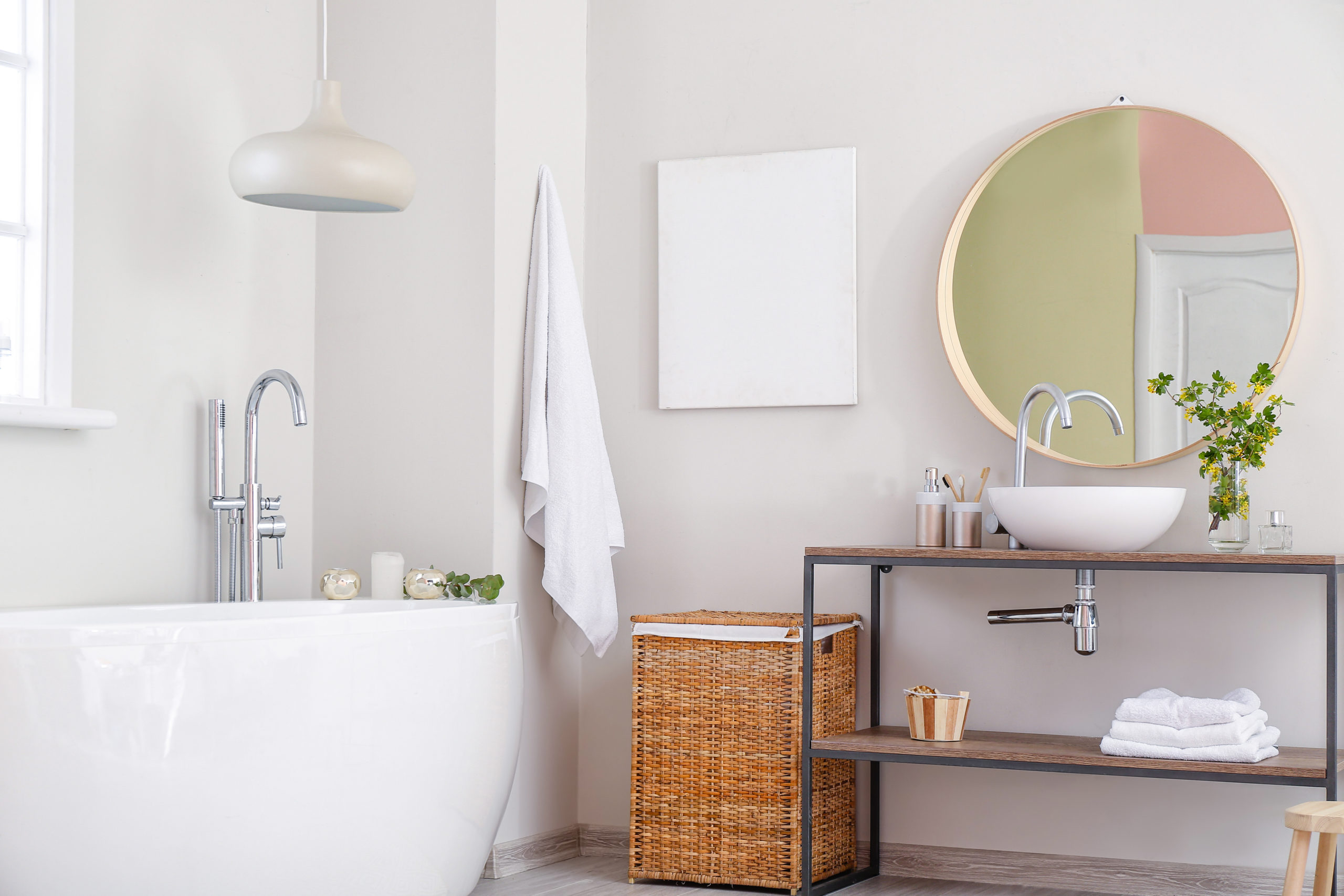Common Pests in Every Room of the House – Part 1
Common Pests in Every Room of the House – Part 1
This is the first of two blogs detailing each of the rooms in an average house and the common pests that tend to favor certain areas more than others. Pests can come into any room in a home and find a way to make themselves comfortable in that space. But some pests prefer specific rooms of the home that have their desired food, shelter, and nesting site. It is not a guarantee that a pest will stay in the original room it entered, but it is worth noting their preferences in order to be on the lookout in these areas.
Kitchen

Kitchens are popular among pests because of the food that is often left out and the warm environment. It is often the first place a pest is seen in a home, and it is usually one of these critters:
- Ants: Ants are a clear kitchen pest, as they can be found anywhere that there is a food source. Since they gravitate toward any food they can smell, they will force their way into anything that contains traces of a leftover meal or ingredient. This includes the toaster, coffee maker, fridge, pantry, and counter spaces. Many ant species look the same to the average person, since the pests are so small and many of them are the same dark color. But some of the most common ants that are found in kitchens are commonly referred to as “sugar ants,” which are either odorous house ants or pavement ants. The best way to tell the difference between the two is to look at their body shapes, as pavement ants have a spine that looks like two bumps between its thorax and abdomen.
- Cockroaches: Similarly, roaches are very attracted to any traces of food in the kitchen. They can live in the fridge, dishwasher, toaster, loose backsplash, and under the sink. The area under the sink is likely the most common space in a kitchen to find roaches because it is dark, undisturbed, warm, and sometimes humid. The pipes and water lines also provide an easy way into the kitchen, since the cockroaches can just follow them from outside.
- Rodents: Rodents are the prime kitchen pests, since they live to gnaw and chew on everything and the kitchen is the perfect place to do that. They chew through the wall, wires, and cords in order to get where they need to be to eat and live. Rats and mice are difficult to overcome due to their ability to live in most environments, including refrigerators, garbage cans, pet food containers, and opened food containers. Rodents are an especially dangerous pest because of the harmful diseases, like salmonella and plague, that they spread through their feet and droppings.
- Flies: Anyone who has tried to eat outside in even slightly warm weather knows that flies love food. House flies seek out old and rotting food because it is the perfect place to lay their eggs and allow the maggots to hatch in a place that already has nutrients waiting for them. This is why flies often land on rotten fruits, spoiled vegetables, uncovered trash in a trash can, and dirty dishes. But they do not exclusively gravitate towards spoiled food, as flies will enjoy just about any food that a human does. These pests are also known for spreading germs that can lead to salmonella or E. Coli and thereby infect any food, good or bad.
- Pantry Pests: This name refers to the small pests that favor the pantry in a kitchen and are able to press themselves through small cracks and holes. Pantry pests, like moths and tiny beetles, love dried goods and seek them out as soon as they get into the area. This is why it is especially important to properly seal containers that have crackers, nuts, grains, cereal, beans, and spices. Pantry pests can enter unopened food as well, and can invade the kitchen as early as when the food is brought home from the grocery store, so their appearance does not mean that you have a dirty kitchen. It just means that these insects found your dried goods interesting.
The best way to protect your kitchen from pest invasions is to keep all food put away and clean up any spills or crumbs right away. Make sure to also seal up any cracks or openings in cabinets and around appliances, since these are easy access points for pests. Kitchen pests love this space because it has all of their essentials – food, water, and shelter – so it is crucial to keep as clean a space as possible in order to prevent these invasions.
Living Room/Family Room

The living area can have a wide range of invading pests since the room usually has a sliding door that leads outside and possibly a couple of windows. It is easy to have these pests go unnoticed if the area is large enough, but some of these pests will not stay unseen for long.
- Field Cricket: These insects may seem invisible, but they will not be unheard for long. Their classic chirping sound is loud, especially in an enclosed space. Crickets come in through any open windows and doors, but they can also sneak in through cracks in the house. Crickets are attracted to heavy lighting and cool places, which is why they usually come in by the patio. They cannot harm humans, but they do become nuisances when they spoil any kind of cloth object, like clothing or curtains, with their droppings and mating.
- Spider: Spiders of all kinds are drawn to areas that have pests already living there, as the spider can easily build a web and trap their prey. Spiders have the ability to climb up walls and ceilings, thanks to their minuscule hairs that create a bond between their legs and the molecules of most surfaces. House spiders do not bite unless they are attacked. Daddy Long Legs, or the Cellar Spider, is also commonly found inside since it seeks shelter where they can make their cobweb in a nice corner. Due to spiders’ ability to float with the wind and walk on many surfaces, they can easily find their way inside through a slider, window, or small crevice in the wall.
- Brown Marmorated Stink Bug: These ugly brown bugs are constantly seen outside in the warmer months, but they will force their way inside a home to shelter for the incoming cold toward the end of the year. They will enter through any means necessary, including cracks and vents. This type of stink bug is more harmful to plants than to humans, but their odor is reason enough to get rid of them. Stink bugs don’t live for very long, but their hundreds of eggs hatch very quickly, so it is important to take care of the problem before it is too late.
Some easy preventative measures to take against living room pests is to keep all sliders and windows closed when you are not around to keep an eye out for any unwelcome house guests. Check the seal on each door and window as well to be sure that they are effectively sealed when they are closed. Also, if food and drinks are commonly consumed in this space, wipe up any crumbs or spills and properly put the food away when you are finished. It may not be the kitchen, but determined pests will find a way to get to our food, no matter what room we are in.
Bathroom

The bathroom is another common place to find insects because many of them are attracted to the moisture and enclosed space. The humidity in the air after a shower is ideal for many pests to live and thrive in. The one necessity they are missing in this area is food, but for pests that eat bacteria and other insects, that problem is quickly resolved.
- Silverfish: Silverfish are appropriately named due to their silvery appearance and attraction to humidity and moisture. They will often run when a light is turned on, and since they are so fast, it is difficult to catch and kill them like other small bugs. Silverfish cause more damage than one may think, including harming gutters, wallpaper, boxes, and pipes. Since they disappear so quickly when they are spotted, the most obvious sign of their presence is a yellow powder that is dispersed when they molt.
- Earwigs: Earwigs do not crawl in our ears when we sleep, but they do love being in wet environments, making the bathroom an ideal place for them to live. They can be found under the sink or in the shower, since they seek out water. Earwigs are also often seen on the floor as they are searching for the moisture they love. They don’t actively bite or sting humans, but their pincers will be put to use if a predator gets too close.
- Cockroaches: Roaches will invade anywhere that there is food, but the bathroom is a particular favorite of theirs. The clutter from supplies and dirty laundry provides shelter, while the bacteria and waste that is found in a bathroom is perfect for them and their diets. They prefer darkness and are active during the nighttime, so they can usually be found under long-standing piles of laundry, the sink, and behind walls.
- Drain flies: Appropriately named, the drain fly is often found in or near the drain of a shower or sink. They look for decomposing materials and water, so the bathroom is prime real estate for them. They can also be found on the ceiling, as they wait for decaying things to become available in the shower, sink, or toilet. Drain flies are harmless to humans besides the amount of germs and bacteria they spread due to their disgusting preferred diet.
- Spiders: Spiders make themselves comfortable in just about every room of the house, and the bathroom is no exception. There are numerous scary occasions in many people’s lives where the shower curtain is innocently moved aside to reveal a spider on the bottom of the tub. The high humidity is what draws the arachnids in, and since they can survive without water for a long time, they can survive in bathrooms by simply waiting for the shower to come on every day.
- Centipedes: These horrifying insects thrive in humidity and live off of smaller bugs, making them the perfect pest candidate to live in a bathroom. They are difficult to catch and kill without help, as they are very fast due to their many legs. While the fact that they enjoy eating other insects is a positive, they become pests when they make themselves welcome in our homes just because they love the moist, dark environment of the drains.
Bathrooms are another common spot for pests since they offer easy access to water and plenty of places to hide. Keep the area clean and free of clutter, and make sure to fix any leaks or moisture issues. It can also help to keep the toilet lid down to prevent drain flies gathering near it. Another preventative measure is to use the ceiling vent fan every time the shower is used. By keeping the fan running during a shower, the moisture in the air will decrease and the bathroom will be less humid, and therefore less appealing to these pests.
Pest Control
Pests can come into any room in a home, but some rooms are more popular among pests than others. Kitchens, bathrooms, and bedrooms all offer different things that pests love and need, such as food, water, and shelter. Contact pest control to get help with preventing or eradicating an invasion of any kind. Keep your home pest free by being aware of their favorite spots and taking the necessary steps to prevent them from entering these areas. Stay tuned to find out which pests love the rest of the rooms in a house and how to prevent them from living rent-free in your home.
Citations
Common kitchen bugs & insects. (n.d.). Pest World. Retrieved February 28, 2022, from https://www.pestworld.org/pest-in-the-house/kitchen/
Food Network Kitchen. (n.d.). Everything you need to know about pantry pests. Food Network. Available at https://www.foodnetwork.com/recipes/packages/kitchen-fixes/everything-about-pantry-pests (Accessed on February 28, 2022).
Inman, K. (2019, February 11). The top 5 places bugs could be hiding in your kitchen. 10 News. Available at https://www.wbir.com/article/news/the-top-5-places-bugs-could-be-hiding-in-your-kitchen/51-7348f6fe-f2db-452a-be9d-8e888f100868 (Accessed on February 28, 2022).
McMillan, G. (n.d.). 9 common bugs exterminators find in most bathrooms. Bathroom Flair. Available at https://bathroomflair.com/9-common-bugs-exterminators-find-in-most-bathrooms/ (Accessed on February 28, 2022).
Shiffer, E. (2021, May 13). 15 common house bugs and how to identify them, according to insect experts. Prevention. Available at https://www.prevention.com/life/g30548446/common-house-bugs/ (Accessed on February 28, 2022).
Request a Free Quote Today
(We do not share your data with anybody, and only use it for its intended purpose)
